
Mexican cuisine consists of the cooking cuisines and traditions of the modern country of Mexico. Its earliest roots lie in Mesoamerican cuisine. Its ingredients and methods begin with the first agricultural communities such as the Olmec and Maya who domesticated maize, created the standard process of nixtamalization, and established their foodways. Successive waves of other Mesoamerican groups brought with them their cooking methods. These included: the Teotihuacanos, Toltec, Huastec, Zapotec, Mixtec, Otomi, Purépecha, Totonac, Mazatec, Mazahua, and Nahua. With the Mexica formation of the multi-ethnic Triple Alliance, culinary foodways became infused.
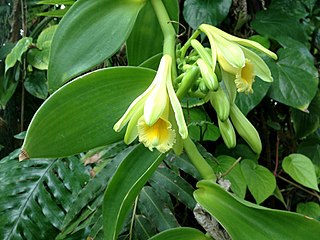
Vanilla is a spice derived from orchids of the genus Vanilla, primarily obtained from pods of the flat-leaved vanilla (V. planifolia).

Chili peppers, also spelled chile or chilli, are varieties of the berry-fruit of plants from the genus Capsicum, which are members of the nightshade family Solanaceae, cultivated for their pungency. Chili peppers are widely used in many cuisines as a spice to add "heat" to dishes. Capsaicin and related compounds known as capsaicinoids are the substances that give chili peppers their intensity when ingested or applied topically. Chili peppers exhibit a wide range of heat and flavors. This diversity is the reason behind the availability of different types of paprika and chili powder, each offering its own distinctive taste and heat level.

In agriculture, a milpa is a field for growing food crops and a crop-growing system used throughout Mesoamerica, especially in the Yucatán peninsula, in Mexico. The word milpa derives from the Nahuatl words milli and pan. Based on the agronomy of the Maya and of other Mesoamerican peoples, the milpa system is used to produce crops of maize, beans, and squash without employing artificial pesticides and artificial fertilizers.

Agriculture in Mesoamerica dates to the Archaic period of Mesoamerican chronology. At the beginning of the Archaic period, the Early Hunters of the late Pleistocene era led nomadic lifestyles, relying on hunting and gathering for sustenance. However, the nomadic lifestyle that dominated the late Pleistocene and the early Archaic slowly transitioned into a more sedentary lifestyle as the hunter gatherer micro-bands in the region began to cultivate wild plants. The cultivation of these plants provided security to the Mesoamericans, allowing them to increase surplus of "starvation foods" near seasonal camps; this surplus could be utilized when hunting was bad, during times of drought, and when resources were low. The cultivation of plants could have been started purposefully, or by accident. The former could have been done by bringing a wild plant closer to a camp site, or to a frequented area, so it was easier access and collect. The latter could have happened as certain plant seeds were eaten and not fully digested, causing these plants to grow wherever human habitation would take them.

The Three Sisters are the three main agricultural crops of various indigenous peoples of Central and North America: squash, maize ("corn"), and climbing beans. In a technique known as companion planting, the maize and beans are often planted together in mounds formed by hilling soil around the base of the plants each year; squash is typically planted between the mounds. The cornstalk serves as a trellis for climbing beans, the beans fix nitrogen in their root nodules and stabilize the maize in high winds, and the wide leaves of the squash plant shade the ground, keeping the soil moist and helping prevent the establishment of weeds.
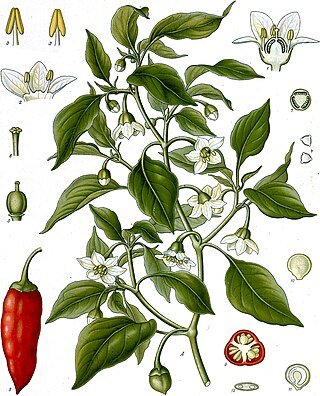
Capsicum annuum is a fruiting plant from the family Solanaceae (nightshades), within the genus Capsicum which is native to the northern regions of South America and to southwestern North America. The plant produces berries of many colors including red, green, and yellow, often with pungent taste. It also has many varieties and common names including paprika, chili pepper, jalapeño, cayenne, bell pepper, and many more with over 200 variations within the species. It is also one of the oldest cultivated crops, with domestication dating back to around 6,000 years ago in regions of Mexico. The genus Capsicum has over 30 species but Capsicum annuum is the primary species in its genus, as it has been widely cultivated for human consumption for a substantial amount of time and has spread across the world. This species has many uses in culinary applications, medicine, self defense, and can even be ornamental.

Indigenous cuisine of the Americas includes all cuisines and food practices of the Indigenous peoples of the Americas. Contemporary Native peoples retain a varied culture of traditional foods, along with the addition of some post-contact foods that have become customary and even iconic of present-day Indigenous American social gatherings. Foods like cornbread, turkey, cranberry, blueberry, hominy, and mush have been adopted into the cuisine of the broader United States population from Native American cultures.
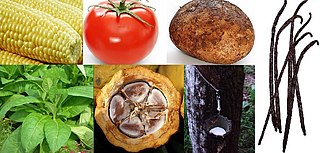
New World crops are those crops, food and otherwise, that are native to the New World and were not found in the Old World before 1492 AD. Many of these crops are now grown around the world and have often become an integral part of the cuisine of various cultures in the Old World. Notable among them are the "Three Sisters": maize, winter squash, and climbing beans.
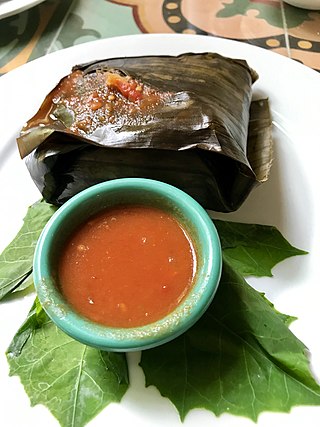
Ancient Maya cuisine was varied and extensive. Many different types of resources were consumed, including maritime, flora, and faunal material, and food was obtained or produced through strategies such as hunting, foraging, and large-scale agricultural production. Plant domestication concentrated upon several core foods, the most important of which was maize.
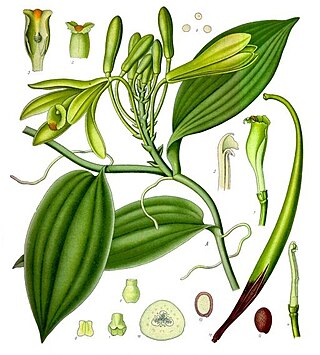
Vanilla planifolia is a species of vanilla orchid native to Mexico, Central America, Colombia, and Brazil. It is one of the primary sources for vanilla flavouring, due to its high vanillin content. Common names include flat-leaved vanilla, and West Indian vanilla. Often, it is simply referred to as "the vanilla". It was first scientifically named in 1808. With the species' population in decline and its habitats being converted to other purposes, the IUCN has assessed Vanilla planifolia as Endangered.

The early impact of Mesoamerican goods on Iberian society had a unique effect on European societies, particularly in Spain and Portugal. The introduction of American "miracle foods" was instrumental in pulling the Iberian population out of the famine and hunger that was common in the 16th century. Maize (corn), potatoes, turkey, squash, beans, and tomatoes were all incorporated into existing Spanish and Portuguese cuisine styles. Equally important was the impact of coffee and sugar cane growing in the New World. Along with the impact from food, the introduction of new goods also altered how Iberian society worked. One can categorize the impacts of these New World goods and foods based on their influence over the state, the economy, religious institutions, and the culture of the time. The power and influence of the state grew as external entities became dependent on Spain for these New Goods in the early 16th century. The economies of both Portugal and Spain saw an enormous increase in power as a result of trading these American goods.

Capsicum is a genus of flowering plants in the nightshade family Solanaceae, native to the Americas, cultivated worldwide for their chili pepper or bell pepper fruit.
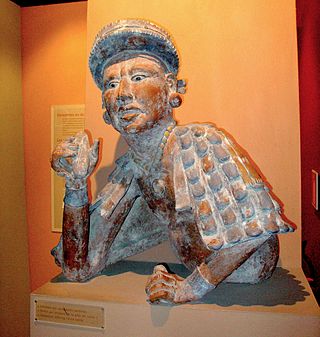
Pre-Columbian cuisine refers to the cuisine consumed by the Indigenous peoples of the Americas before Christopher Columbus and other European explorers explored the region and introduced crops and livestock from Europe. Though the Columbian Exchange introduced many new animals and plants to the Americas, Indigenous civilizations already existed there, including the Aztec, Maya, Incan, as well as various Native Americans in North America. The development of agriculture allowed the many different cultures to transition from hunting to staying in one place. A major element of this cuisine is maize (corn), which began being grown in central Mexico. Other crops that flourished in the Americas include amaranth, wild rice, and lima beans.
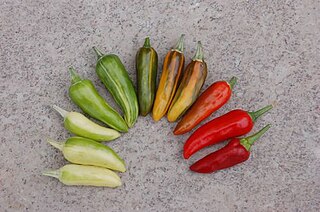
The fish pepper is a small Chili pepper cultivar of the species Capsicum annuum. It is an heirloom variety developed and preserved by African American communities in the Chesapeake. The plant has variegated foliage and its peppers ripen from white with green streaks to a dark red color. The fish pepper has a wide range of pungency, with Scoville scores from 5,000 to 30,000 units. The pepper was thought to be extinct for the better part of the 20th century until the rediscovery of fifty year-old seeds in an African American family's freezer.

The Archaic period, also known as the preceramic period, is a period in Mesoamerican chronology that begins around 8000 BCE and ends around 2000 BCE and is generally divided into Early, Middle, and Late Archaic periods. The period is preceded by the Paleoindian period and followed by the Preclassic period. Scholars have found it difficult to determine exactly when the Paleoindian period ends and the Archaic begins, but it is generally linked with changing climate associated with the transition from the Pleistocene to the Holocene epochs, and absence of extinct Pleistocene animals. It is also generally unclear when the Archaic period ends and the Preclassic period begins, though the appearance of pottery, large-scale agriculture, and villages signal the transition.
The Archaic period is traditionally viewed as a long, transitional interval between the hunter-gatherers of the Paleoindian period and the proliferation of agricultural villages in the Preclassic. This period is known for the domestication of major Mesoamerican crops, the development of agriculture, and the beginning of sedentism. The major developments in agriculture and sedentism during this time allowed for the rise of complex societies in the region. These developments were not uniform throughout Mesoamerica and often differed regionally.
Mesoamerican cuisine – has four main staples: maize, beans, squash and chili. Other plant-based foods used include: amaranth, avocado, cassava, cherimoya, chia, chocolate, guava, nanche, pineapple, sapodilla, sweet potatoes, yucca and zapote.















